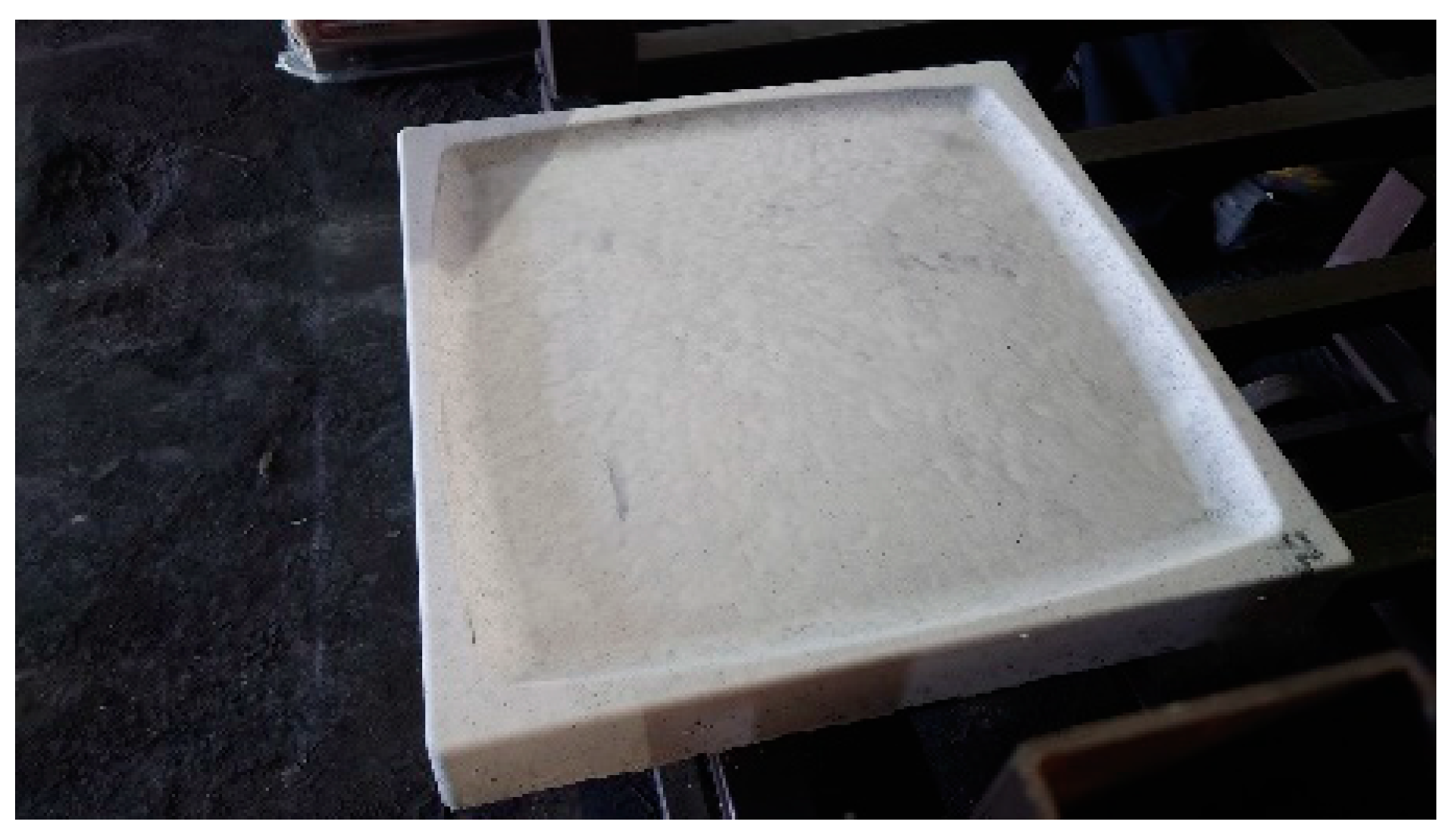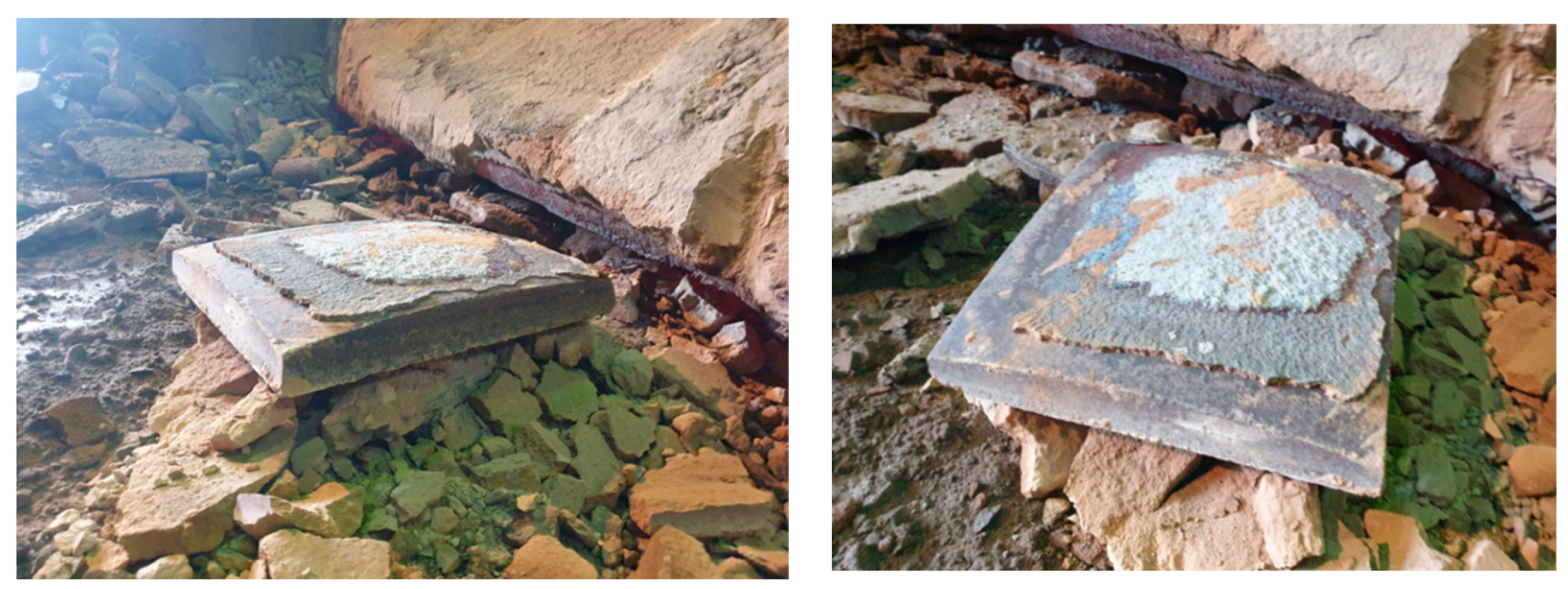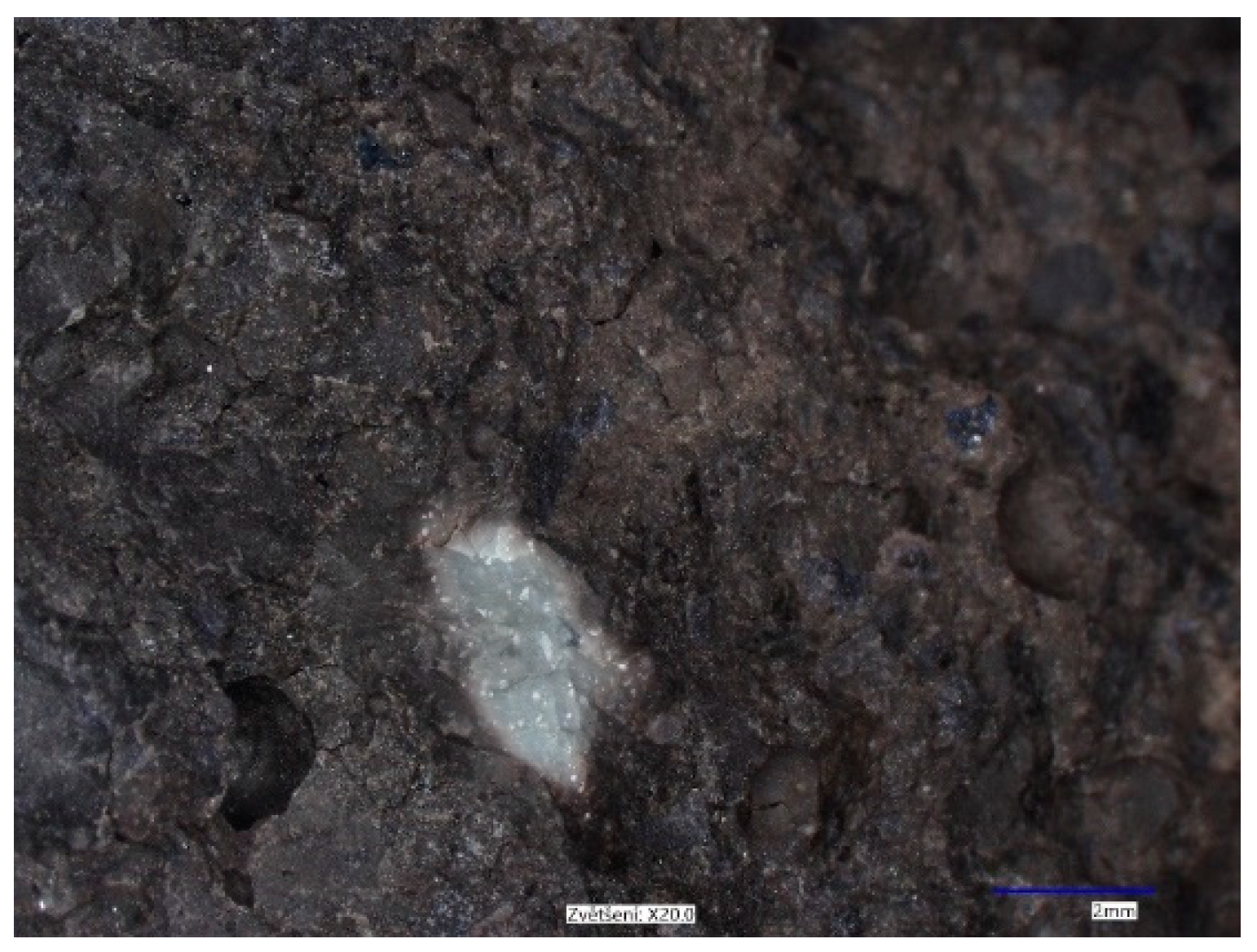The Benefits of Using an Advanced Material for Production of Spherical Impact Pad for Tundish †
Abstract
1. Introduction
2. Methodology
- (1)
- Create a material capable of enduring prolonged exposure to the dynamic conditions of liquid steel without altering the shape of surfaces that regulate the flow of prefabricated elements, especially in the area where steel enters the tundish;
- (2)
- Furthermore, the intention was to formulate a composition for fabricating these prefabricated elements that minimizes energy usage and reduces the carbon footprint. To meet these goals, the concept of utilizing low-carbon concrete (LCC) and ultra-low carbon concrete (ULCC) for the production of these elements was discarded due to significant limitations, particularly in relation to objectives (1) and (2).
3. Results Analysis
4. Conclusions
Author Contributions
Funding
Institutional Review Board Statement
Informed Consent Statement
Data Availability Statement
Conflicts of Interest
References
- Buľko, B.; Priesol, I.; Demeter, P.; Gašparovič, P. Geometric Modification of the Tundish Impact Point and the Advanced Material for this Application. Available online: https://www.alafar.org/papers/2022/03-Bulko.pdf (accessed on 1 December 2022).
- Buľko, B.; Fogaraš, L.; Hubatka, S.; Demeter, P.; Ondrejkovič, K.; Buček, P. Verification of non-standard f-curves during steel intermixing in a tundish. Metalurgija 2023, 62, 187–190. [Google Scholar]
- Tkadleckova, M.; Valek, L.; Socha, L.; Saternus, M.; Pieprzyca, J.; Merder, T.; Michalek, K.; Kovac, M. Study of solidification of continuously cast steel round billets using numerical modelling. Arch. Metall. Mater. 2016, 61, 221–226. [Google Scholar] [CrossRef]
- Michalek, K.; Tkadleckova, M.; Socha, L.; Gryc, K.; Saternus, M.; Pieprzyca, J.; Merder, T. Physical Modelling of Degassing Process by Blowing of Inert Gas. Arch. Metal. Mater. 2018, 63, 987–992. [Google Scholar]
- Socha, L.; Bazan, J.; Gryc, K.; Moravka, J.; Styrnal, P.; Pilka, V.; Piegza, Z. Optimalisation of the Slag Mode in the Ladle During the Steel Processing of Secondary Metallurgy. Mater. Tehnol. 2013, 47, 673–678. [Google Scholar]
- Prášil, T.; Socha, L.; Gryc, K.; Sviželová, J.; Saternus, M.; Merder, T.; Pieprzyca, J.; Gráf, M. Using Physical Modeling to Optimize the Aluminium Refining Process. Materials 2022, 15, 7385. [Google Scholar] [CrossRef] [PubMed]
- Warzecha, M. Numerical Modelling of Non-Metallic Inclusion Separation in a Continuous Casting Tundish. Comput. Fluid Dyn. Technol. Appl. 2011. [Google Scholar] [CrossRef]
- Sviželová, J.; Tkadlečková, M.; Michalek, K.; Strouhalová, M. Influence of Casting Speed on Centerline Porosity Formation in Continuously Cast Round Steel Billets. In Proceedings of the METAL 2017: 26TH International Conference on Metallurgy and Materials, Brno, Czech Republic, 24–26 May 2017; TANGER: Ostrava, Czech Republic, 2017; pp. 235–240, ISBN 978-80-87294-79-6. [Google Scholar]
- Worldsteel Association. Steel Statistical Yearbook. 2016. Available online: https://www.worldsteel.org/publications/bookshop/product-details.~Steel-Statistical-Yearbook-2016~PRODUCT~SSY2016~.html (accessed on 22 April 2023).
- Tkadlečková, M.; Michalek, K.; Socha, L.; Válek, L.; Sviželová, J. Investigation of technology of continuously cast steel billets using numerical modelling. In Proceedings of the METAL 2016: 25th International Conference on Metallurgy and Materials, Brno, Czech Republic, 25–27 May 2016; TANGER: Ostrava, Czech Republic, 2016; pp. 60–65, ISBN 978-80-87294-67-3. [Google Scholar]
- Buľko, B.; Molnár, M.; Demeter, P. Physical modeling of different configurations of a tundish for casting grades of steel that must satisfy stringent requirements on quality. Metallurgist 2014, 57, 976–980. [Google Scholar] [CrossRef]
- Chatterjee, D. Designing of a novel shroud for improving the quality of steel in tundish. Adv. Mater. Res. 2012, 585, 359–363. [Google Scholar] [CrossRef]
- Priesol, I. A Method of Molten Metal Casting Utilizing an Impact Pad in the Tundish. International Patent Application No. PCT/IB2016/056207, 10 October 2016. [Google Scholar]
- Priesol, I. Spôsob Liatia Roztaveného Kovu s Využitím Dopadovej Dosky v Medzipanve. International Patent Classification: B22D 11/10 B22D 41/00, Application No. 109-2016, 11 October 2016; B22D 11/00 B22D 41/00, Application No. 89-2016, 10 October 2016. [Google Scholar]
- Priesol, I.; Priesolová, N.; Slosiar, Š.; Vlček, J.; Klárová, M. Comparision of characteristics selected refractory castables using free-cement nano-binder. In Proceedings of the Refractories, Furnaces and the Thermal Insulations 2021—International Conference on Refractory and Thermos Insulation, Košice, Slovakia, 3–5 November 2021. [Google Scholar]





| Chemical Composition | % | Physical Properties | |
|---|---|---|---|
| Al2O3 | 87.4 | Specific gravity after drying 110 °C | 2850 kg·m−3 |
| Fe2O3 | 1.2 | Specific gravity after firing 1400 °C | 2910 kg·m−3 |
| SiO2 | 8.3 | Strength after drying 110 °C | 26 MPa |
| TiO2 | 1.8 | Strength after firing 1400 °C | 110 MPa |
| CaO | 1.3 | Open porosity after firing 1400 °C | 18.8% |
| Permanent linear changes after firing 1200 °C | −0.19% |
Disclaimer/Publisher’s Note: The statements, opinions and data contained in all publications are solely those of the individual author(s) and contributor(s) and not of MDPI and/or the editor(s). MDPI and/or the editor(s) disclaim responsibility for any injury to people or property resulting from any ideas, methods, instructions or products referred to in the content. |
© 2024 by the authors. Licensee MDPI, Basel, Switzerland. This article is an open access article distributed under the terms and conditions of the Creative Commons Attribution (CC BY) license (https://creativecommons.org/licenses/by/4.0/).
Share and Cite
Buľko, B.; Demeter, P.; Priesol, I.; Hubatka, S.; Fogaraš, L.; Demeter, J.; Hrubovčáková, M.; Pylypenko, A.; Dubec, D.; Varcholová, D.; et al. The Benefits of Using an Advanced Material for Production of Spherical Impact Pad for Tundish. Eng. Proc. 2024, 64, 17. https://doi.org/10.3390/engproc2024064017
Buľko B, Demeter P, Priesol I, Hubatka S, Fogaraš L, Demeter J, Hrubovčáková M, Pylypenko A, Dubec D, Varcholová D, et al. The Benefits of Using an Advanced Material for Production of Spherical Impact Pad for Tundish. Engineering Proceedings. 2024; 64(1):17. https://doi.org/10.3390/engproc2024064017
Chicago/Turabian StyleBuľko, Branislav, Peter Demeter, Ivan Priesol, Slavomír Hubatka, Lukáš Fogaraš, Jaroslav Demeter, Martina Hrubovčáková, Andrii Pylypenko, Dominik Dubec, Dagmara Varcholová, and et al. 2024. "The Benefits of Using an Advanced Material for Production of Spherical Impact Pad for Tundish" Engineering Proceedings 64, no. 1: 17. https://doi.org/10.3390/engproc2024064017
APA StyleBuľko, B., Demeter, P., Priesol, I., Hubatka, S., Fogaraš, L., Demeter, J., Hrubovčáková, M., Pylypenko, A., Dubec, D., Varcholová, D., & Lapenko, O. (2024). The Benefits of Using an Advanced Material for Production of Spherical Impact Pad for Tundish. Engineering Proceedings, 64(1), 17. https://doi.org/10.3390/engproc2024064017








